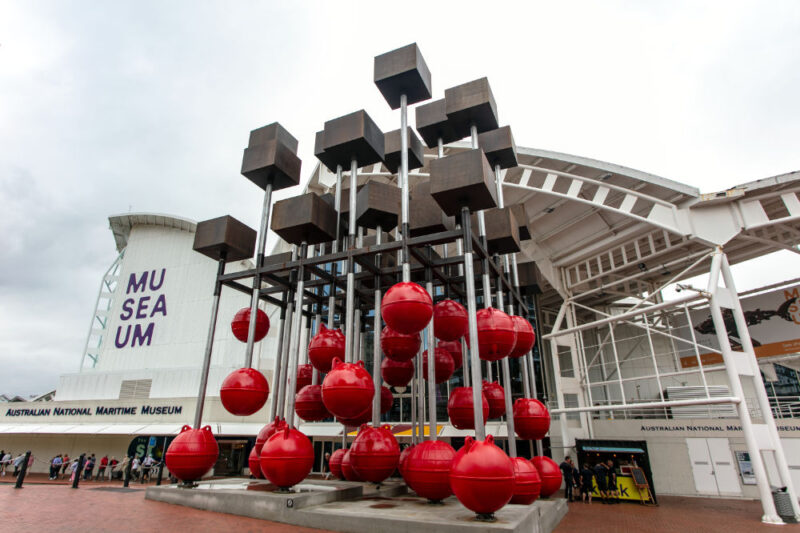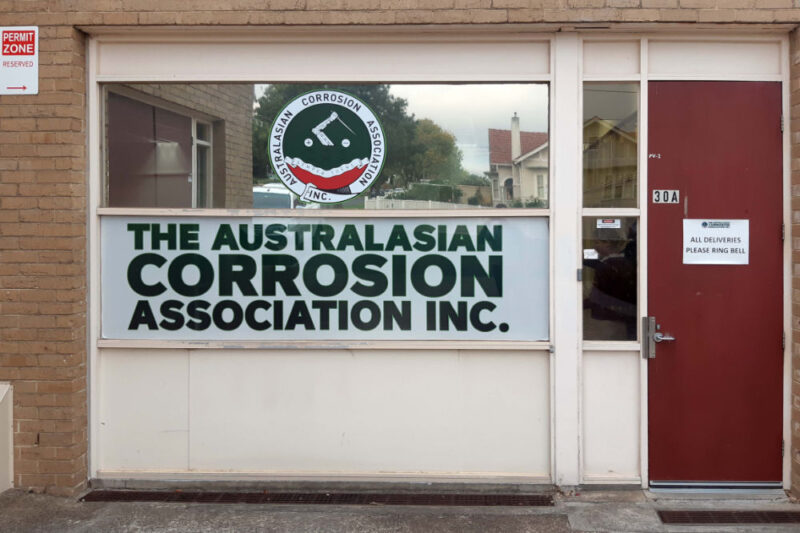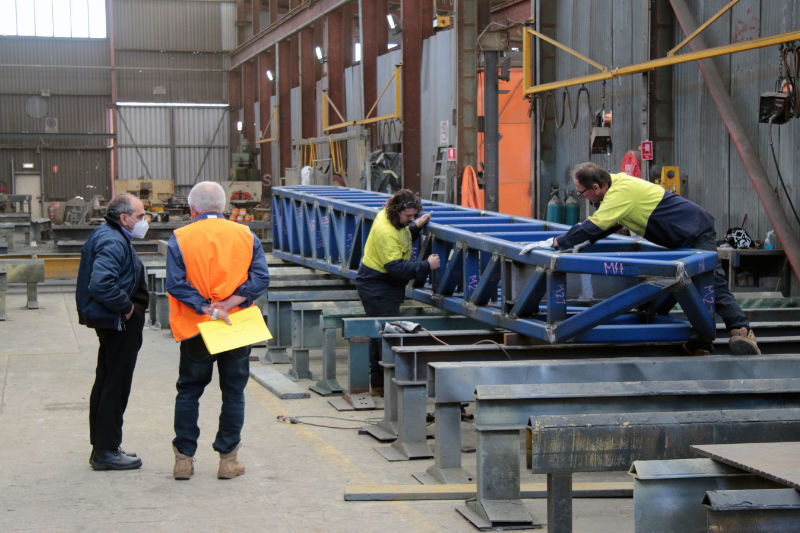
Downward Force on Upward Moving Objects (2018), Wang Luyan. Image: ANMM
Thanks to the generosity of the Association of Australian Decorative and Fine Arts Societies (ADFAS) and the Patricia Robertson Fund, I attended the Australasian Corrosion Association’s Coating Selection and Specification training program in early 2021.
ADFAS’s Mid-career Scholarship provides financial support for the professional development of a conservator with 10 years’ experience. Previous winners have used the award to attend conferences and workshops in glamorous international destinations, such as London, New York, Munich and West Dean. My horizons, on the other hand, were a little closer to home. Preston, in the northern suburbs of Melbourne, provided the perfect setting for training during a global pandemic.

Australasian Corrosion Association’s facilities in Preston, Victoria. Image: N Flood
As the name suggests, the Coating Selection and Specification course is designed to train participants on how to choose the best paint system for a given situation and how to write a technical specification that ensures painting work is carried out correctly. Both of these skills are essential in the conservation of painted cultural objects that exist in outdoor locations.
Background
My role at the Australian National Maritime Museum (ANMM), Senior Conservator – Special Projects, means that I’m responsible for the conservation of artistic, historic and technology objects held by the museum. These objects include painted contemporary sculpture, a lighthouse structure and large industrial equipment.

Cape Bowling Green Lighthouse in 2017, before and after treatment. Images: N Flood.
The conservation of cultural objects in the outdoor environment can be a difficult and expensive undertaking that requires significant expertise. Misguided treatments can lead to results that may fail rapidly, giving need for costly maintenance. Large financial outlays and the high potential for failure, sadly means that many cultural objects kept out-of-doors are neglected.
The conservator is in a unique position to help ensure the long-term preservation of this cultural material in a sympathetic, sustainable and cost-effective manner. Conservators bridge the gap between ethical and technical treatment considerations. However, rapid changes in the paint industry have made it difficult for the conservation profession to keep abreast of advances in the field. The challenge of preserving outdoor painted objects can only be addressed when conservators are armed with training in both conservation ethics and paint technology.
For several years now, I have worked to build expertise in this area and have undertaken the following training and certification:
- Corrosion Technology Certificate, Australasian Corrosion Association
- Surface Treatment Strategies for Outdoor Painted Sculpture, Getty Conservation Institute (see my previous e-News article)
- Colour Made Simple, Nick Harkness
I am recognised as a Corrosion Technician by the Australasian Corrosion Association owing to the combination of my training and experience
Taking part in the Coating Selection and Specification training program was an opportunity for me to further my technical knowledge of modern commercial and industrial paints.
The training program
The Australasian Corrosion Association is Australia and New Zealand’s professional association for corrosion and its prevention, providing training, seminars, conferences and publications to its members. The Coating Selection and Specification course was delivered by Ted Riding, a chemical engineering and leader in the protective coatings industry with over 40 years’ experience.

Ted Riding lecturing during the Coating Selection and Specification training program. Image: N Flood.
The training program is an industry-based course designed to provide knowledge of modern protective coatings and their application. It teaches participants how to interpret and use Australian Standards that apply to protective coatings in environmental conditions (AS/NZS 2312.1). The program consists of three days of in-person lectures and an assessment, completed by participants in their own time following the course. The training covered topics that included:
- different coating types, their properties and uses
- limitations and advantages of different paint systems
- introduction to modern high-technology coatings (fluoropolymer and polysiloxane paints)
- selection of coatings to provide sustainable results in an outdoor environment
- making decisions based on maintenance and lifetime costs
- writing specifications for contractors
- causes of coatings failure.
The final assessment task was to produce a paint specification document. I chose to use this as an opportunity to consider the treatment of the ANMM’s Cape Bowling Green Lighthouse ahead of work that it requires in the short term.
Besides me, the course was mainly attended by professional engineers and representatives from coating protection companies. It was a chance for me to meet and mix with the people with whom conservators collaborate when designing treatments for culturally significant outdoor objects and structures.

Fabrication of vessel cradle for refugee boat Tu Do. Image: N Flood.
Outcomes
Completion of the Coating Selection and Specification training has empowered me to address the challenges that painted coatings pose to the preservation of outdoor cultural objects. The course has provided direct benefits to my professional development and my duties at the ANMM, including:
- filling out my knowledge of modern commercial and industrial protective coatings and their application
- providing me a detailed understanding of relevant Australian Standards
- giving me the confidence to solve problems in a highly technical area
- equipping me to prepare the paint specification for Cape Bowling Green Lighthouse (assessment task) for the lighthouse’s maintenance in 2021–22
- improving ANMM’s approach to corrosion and paint issues affecting Wang Luyan sculptures and their maintenance
- interpreting engineer’s specifications and review of tender documents relating to the fabrication and painting of a support structure for ANMM’s refugee vessel Tu Do
- expanding professional network connections with engineers, technical representatives and applicators
- sharing my knowledge with Conservation and Facilities teams at the ANMM.

Engineers inspecting the Wang Luyan sculpture. Image: N Flood.
Conclusions
Thanks to the generous ADFAS Mid-career Scholarship, I have successfully completed the Australasian Corrosion Association’s Coating Selection and Specification training program. This course has provided me with new knowledge on modern protective coatings and given me the ability to design and document paint specifications. This is of substantial benefit to me in my professional development and my role at the ANMM. It’s through training like this that the gap between technical and ethical considerations can be bridged, leading the way for better preservation outcomes for painted outdoor sculpture and cultural material across Australia.

Thanks to ADFAS, AICCM, ACA and ANMM for giving me this opportunity.